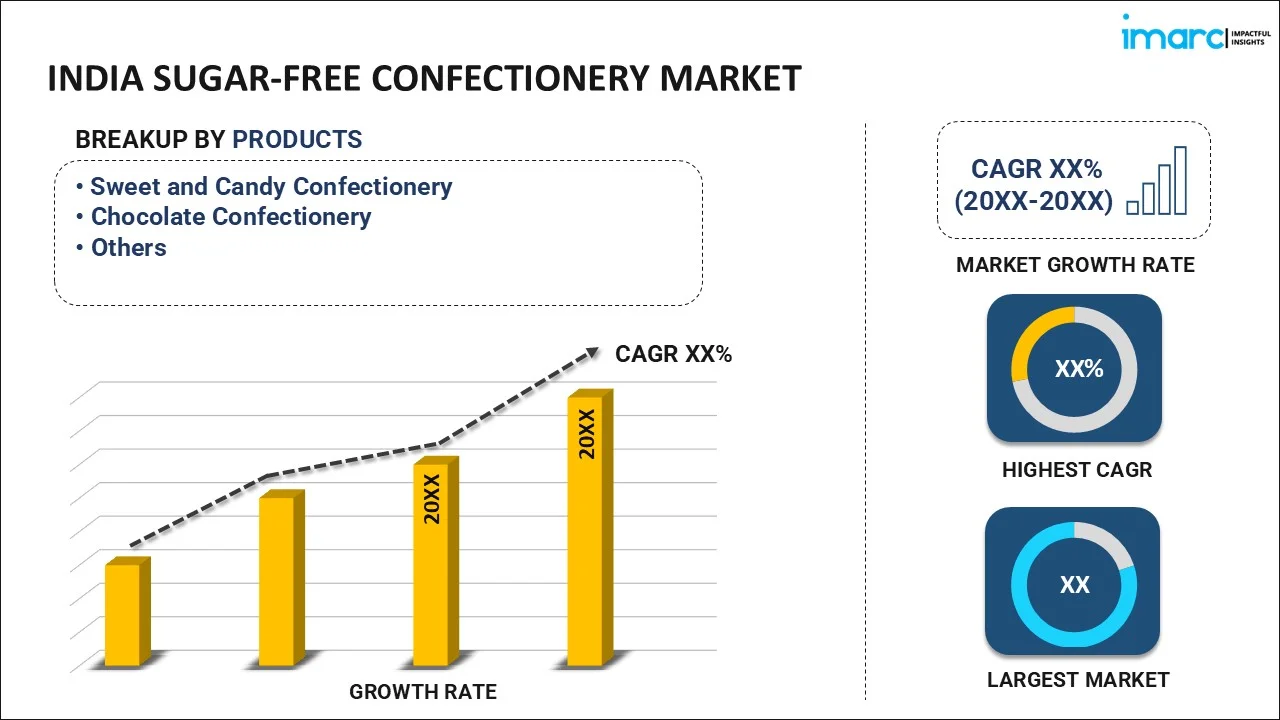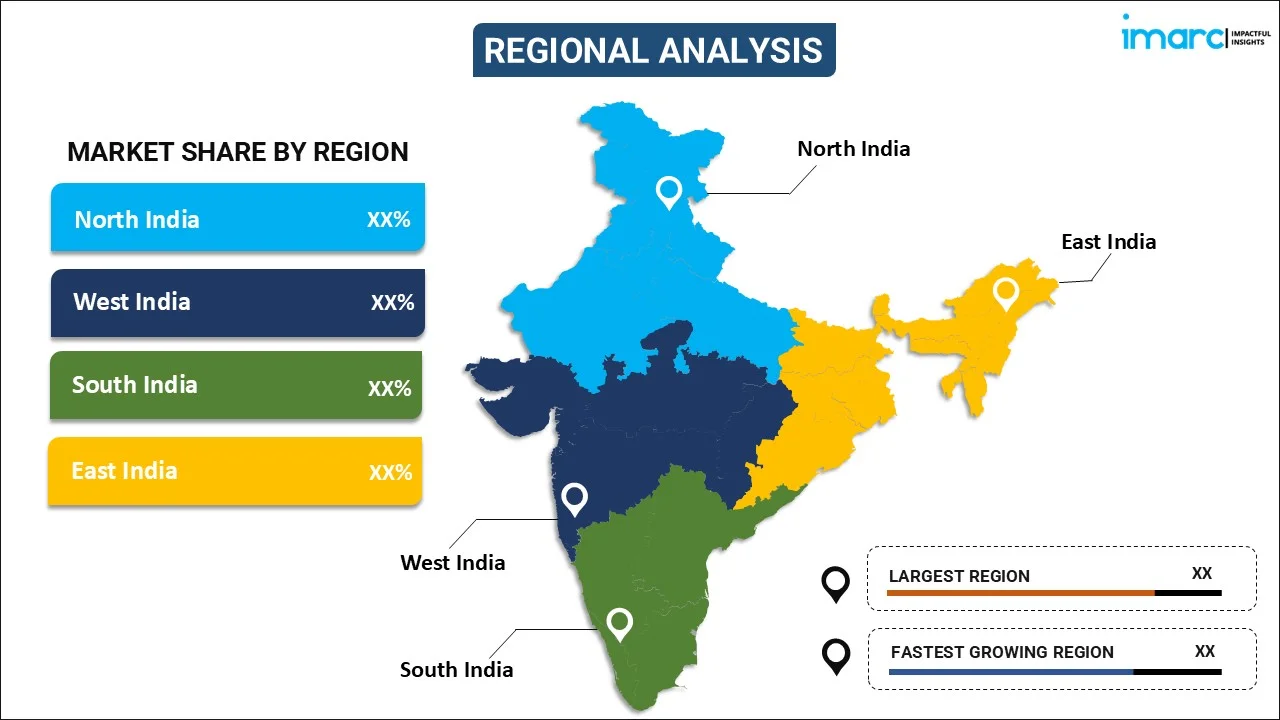
India Sugar-Free Confectionery Market Size, Share, Trends and Forecast by Product, Distribution Channel, and Region, 2025-2033
India Sugar-Free Confectionery Market Overview:
The India sugar-free confectionery market size reached USD 72.23 Million in 2024. Looking forward, IMARC Group expects the market to reach USD 120.22 Million by 2033, exhibiting a growth rate (CAGR) of 5.38% during 2025-2033. The rising health consciousness, increasing diabetic and obese populations, growing demand for low-calorie sweets, advancements in sugar substitutes, urbanization, and expanding retail channels are the factors propelling the growth of the market. Government initiatives promoting sugar reduction further support market growth.
|
Report Attribute
|
Key Statistics
|
|---|---|
|
Base Year
|
2024 |
|
Forecast Years
|
2025-2033
|
|
Historical Years
|
2019-2024
|
| Market Size in 2024 | USD 72.23 Million |
| Market Forecast in 2033 | USD 120.22 Million |
| Market Growth Rate (2025-2033) | 5.38% |
India Sugar-Free Confectionery Market Trends:
Rising Demand for Healthier Sweet Alternatives
Consumers are increasingly opting for sugar-free confectionery as awareness of health and wellness rises. While traditional sweets remain popular, many individuals are actively seeking alternatives with reduced sugar content. This shift is particularly evident among urban households, where changing lifestyles and dietary habits influence purchasing decisions. Brands are responding by expanding their product lines to include sugar-free versions of chocolates, cookies, and traditional sweets. Innovations in natural sweeteners and formulation techniques are enhancing taste and texture, making these products more appealing to a wider audience. Fitness-conscious consumers and those managing health conditions are driving demand, prompting businesses to focus on clean-label ingredients and functional benefits. With growing accessibility through retail and e-commerce channels, sugar-free options are becoming more mainstream. As preferences evolve, confectionery brands are increasingly positioning their products as both indulgent and health-friendly, ensuring that taste remains uncompromised while catering to a mindful consumer base. According to industry reports, in 2024, about 51% of urban Indian households consumed traditional sweets three or more times monthly, up from 41% in 2023. Furthermore, 55% of these households are open to sweets with 25-75% reduced sugar content, indicating a growing market for sugar-free confectionery.
Changing Landscape of Indian Sweets
Shifting consumer priorities are redefining the traditional sweets market, with a growing preference for options that align with evolving dietary habits. The demand for sweets made without refined sugar is increasing as individuals seek products that maintain authentic flavors while catering to wellness goals. This shift has led to innovations in formulation, incorporating alternative sweetening solutions that enhance taste and texture without compromising quality. The movement is fueled by both personal health considerations and a broader industry response to changing consumption patterns. Manufacturers are introducing refined sugar-free variants of popular sweets, ensuring accessibility across retail and digital platforms. The growing appeal of these offerings reflects a shift toward mindful indulgence, where consumers can enjoy traditional flavors in a reimagined way. With expanding availability and greater acceptance, sugar-free sweets are becoming a prominent category, bridging the gap between cultural preferences and modern lifestyle choices in India’s confectionery market. For instance, in May 2024, Conscious Mitthaiwalla announced its plans to transform India's traditional sweets market by offering sugar-free mithai. Its innovative approach caters to health-conscious consumers, blending traditional flavors with healthier options. This reflects a broader trend in India's confectionery industry, where brands like Nestlé have introduced products without refined sugar to meet evolving consumer preferences.
India Sugar-Free Confectionery Market Segmentation:
IMARC Group provides an analysis of the key trends in each segment of the market, along with forecasts at the region/country level for 2025-2033. Our report has categorized the market based on product and distribution channel.
Product Insights:

- Sweet and Candy Confectionery
- Chocolate Confectionery
- Others
The report has provided a detailed breakup and analysis of the market based on the product. This includes sweet and candy confectionery, chocolate confectionery, and others.
Distribution Channel Insights:
- Supermarkets and Hypermarkets
- Convenience and Drug Stores
- Online and D2C
- Others
A detailed breakup and analysis of the market based on the distribution channel have also been provided in the report. This includes supermarkets and hypermarkets, convenience and drug stores, online and D2C, and others.
Regional Insights:

- North India
- South India
- East India
- West India
The report has also provided a comprehensive analysis of all the major regional markets, which include North India, South India, East India, and West India.
Competitive Landscape:
The market research report has also provided a comprehensive analysis of the competitive landscape. Competitive analysis such as market structure, key player positioning, top winning strategies, competitive dashboard, and company evaluation quadrant has been covered in the report. Also, detailed profiles of all major companies have been provided.
India Sugar-Free Confectionery Market News:
- In December 2024, Artinci, a Bangalore-based sugar-free dessert brand, secured funding from Shark Tank India Season 3. Artinci offers low glycemic index, low-carb, keto-friendly desserts, catering to diabetics and health-conscious consumers. Its product range includes cakes, cookies, and traditional Indian sweets, all crafted without sugar, aligning with the growing demand for healthier indulgence options in India's confectionery market.
- In October 2024, Zydus Wellness introduced Sugar Free D’lite cookies, endorsed by Bollywood actor Shahid Kapoor, to cater to health-conscious consumers seeking sugar-free options. Available in choco chip, yummy berries, and mocha hazelnut flavors, these cookies aim to balance taste and fitness. Sugar Free leads the sweetener market with a 95% share, reflecting India's growing demand for healthier confectionery choices.
India Sugar-Free Confectionery Market Report Coverage:
| Report Features | Details |
|---|---|
| Base Year of the Analysis | 2024 |
| Historical Period | 2019-2024 |
| Forecast Period | 2025-2033 |
| Units | Million USD |
| Scope of the Report |
Exploration of Historical Trends and Market Outlook, Industry Catalysts and Challenges, Segment-Wise Historical and Future Market Assessment:
|
| Product Types Covered | Sweet and Candy Confectionery, Chocolate Confectionery, Others |
| Distribution Channels Covered | Supermarkets and Hypermarkets, Convenience and Drug Stores, Online and D2C, Others |
| Regions Covered | North India, South India, East India, West India |
| Customization Scope | 10% Free Customization |
| Post-Sale Analyst Support | 10-12 Weeks |
| Delivery Format | PDF and Excel through Email (We can also provide the editable version of the report in PPT/Word format on special request) |
Key Questions Answered in This Report:
- How has the India sugar-free confectionery market performed so far and how will it perform in the coming years?
- What is the breakup of the India sugar-free confectionery market on the basis of product?
- What is the breakup of the India sugar-free confectionery market on the basis of distribution channel?
- What are the various stages in the value chain of the India sugar-free confectionery market?
- What are the key driving factors and challenges in the India sugar-free confectionery market?
- What is the structure of the India sugar-free confectionery market and who are the key players?
- What is the degree of competition in the India sugar-free confectionery market?
Key Benefits for Stakeholders:
- IMARC’s industry report offers a comprehensive quantitative analysis of various market segments, historical and current market trends, market forecasts, and dynamics of the India sugar-free confectionery market from 2019-2033.
- The research report provides the latest information on the market drivers, challenges, and opportunities in the India sugar-free confectionery market.
- Porter's five forces analysis assist stakeholders in assessing the impact of new entrants, competitive rivalry, supplier power, buyer power, and the threat of substitution. It helps stakeholders to analyze the level of competition within the India sugar-free confectionery industry and its attractiveness.
- Competitive landscape allows stakeholders to understand their competitive environment and provides an insight into the current positions of key players in the market.
Need more help?
- Speak to our experienced analysts for insights on the current market scenarios.
- Include additional segments and countries to customize the report as per your requirement.
- Gain an unparalleled competitive advantage in your domain by understanding how to utilize the report and positively impacting your operations and revenue.
- For further assistance, please connect with our analysts.
 Inquire Before Buying
Inquire Before Buying
 Speak to an Analyst
Speak to an Analyst
 Request Brochure
Request Brochure
 Request Customization
Request Customization




.webp)




.webp)












